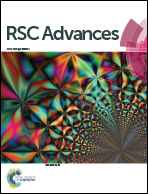SCO@SiO2@Au core–shell nanomaterials: enhanced photo-thermal plasmonic effect and spin-crossover properties†
Abstract
We report here an effective synthetic route to gold coated spin-crossover core–shell nanocomposites (SCO@SiO2@Au) in which [Fe(Htrz)2(trz)](BF4)@SiO2 (SCO@SiO2) served as a support to the Au nanoparticles. The obtained core–shell nanocomposites were studied using numerous characterization techniques to define the structure, morphology, composition and especially the spin-crossover properties. The transmission electron micrographs illustrated that Au nanoparticles with an average diameter around 2.5 nm were decorated uniformly on the surface of SCO@SiO2. X-ray photoelectron spectroscopy measurements further confirmed the successful incorporation of gold nanoparticles on spin-crossover core. The Raman spectrum indicated that the plasmonic Au nanoparticles caused an efficient photo-thermal heating in the SCO@SiO2@Au nanocomposites, leading to a ∼100 times reduction of laser energy needed for spin state switching compared with SCO@SiO2. The magnetic study demonstrated that the embedded Au nanoparticles not only influenced the spin transition temperatures but also changed the widths of hysteresis loops. SCO@SiO2@Au nanocomposites may be applied to various areas where the fascinating spin-crossover core and the functional gold shell can be beneficial.


 Please wait while we load your content...
Please wait while we load your content...